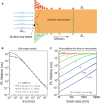Ultrahigh sensitivity of methylammonium lead tribromide perovskite single crystals to environmental gases
- PMID: 29713684
- PMCID: PMC5919775
- DOI: 10.1126/sciadv.1600534
Ultrahigh sensitivity of methylammonium lead tribromide perovskite single crystals to environmental gases
Abstract
One of the limiting factors to high device performance in photovoltaics is the presence of surface traps. Hence, the understanding and control of carrier recombination at the surface of organic-inorganic hybrid perovskite is critical for the design and optimization of devices with this material as the active layer. We demonstrate that the surface recombination rate (or surface trap state density) in methylammonium lead tribromide (MAPbBr3) single crystals can be fully and reversibly controlled by the physisorption of oxygen and water molecules, leading to a modulation of the photoluminescence intensity by over two orders of magnitude. We report an unusually low surface recombination velocity of 4 cm/s (corresponding to a surface trap state density of 108 cm-2) in this material, which is the lowest value ever reported for hybrid perovskites. In addition, a consistent modulation of the transport properties in single crystal devices is evidenced. Our findings highlight the importance of environmental conditions on the investigation and fabrication of high-quality, perovskite-based devices and offer a new potential application of these materials to detect oxygen and water vapor.
Keywords: Organometal trihalide perovskite; gas sensitivity; molecular physisorption; surface passivation; surface recombination velocity.
Figures





References
-
- Jeon N. J., Noh J. H., Yang W. S., Kim Y. C., Ryu S., Seo J., Seok S. I., Compositional engineering of perovskite materials for high-performance solar cells. Nature 517, 476–480 (2015). - PubMed
-
- Zhou H., Chen Q., Li G., Luo S., Song T.-b., Duan H.-S., Hong Z., You J., Liu Y., Yang Y., Interface engineering of highly efficient perovskite solar cells. Science 345, 542–546 (2014). - PubMed
-
- Lee M. M., Teuscher J., Miyasaka T., Murakami T. N., Snaith H. J., Efficient hybrid solar cells based on meso-superstructured organometal halide perovskites. Science 338, 643–647 (2012). - PubMed
-
- Liu M., Johnston M. B., Snaith H. J., Efficient planar heterojunction perovskite solar cells by vapour deposition. Nature 501, 395–398 (2013). - PubMed
-
- Research Cell Efficiency Records (National Renewable Energy Laboratory), available at www.nrel.gov/ncpv/, Rev. 04-20-2016.
LinkOut - more resources
Full Text Sources
Other Literature Sources

